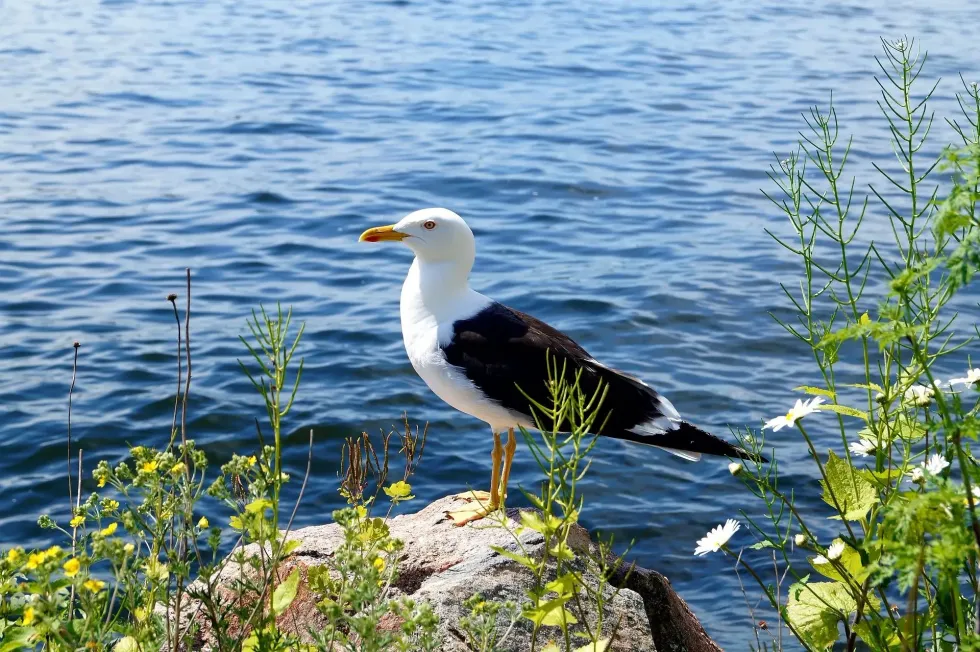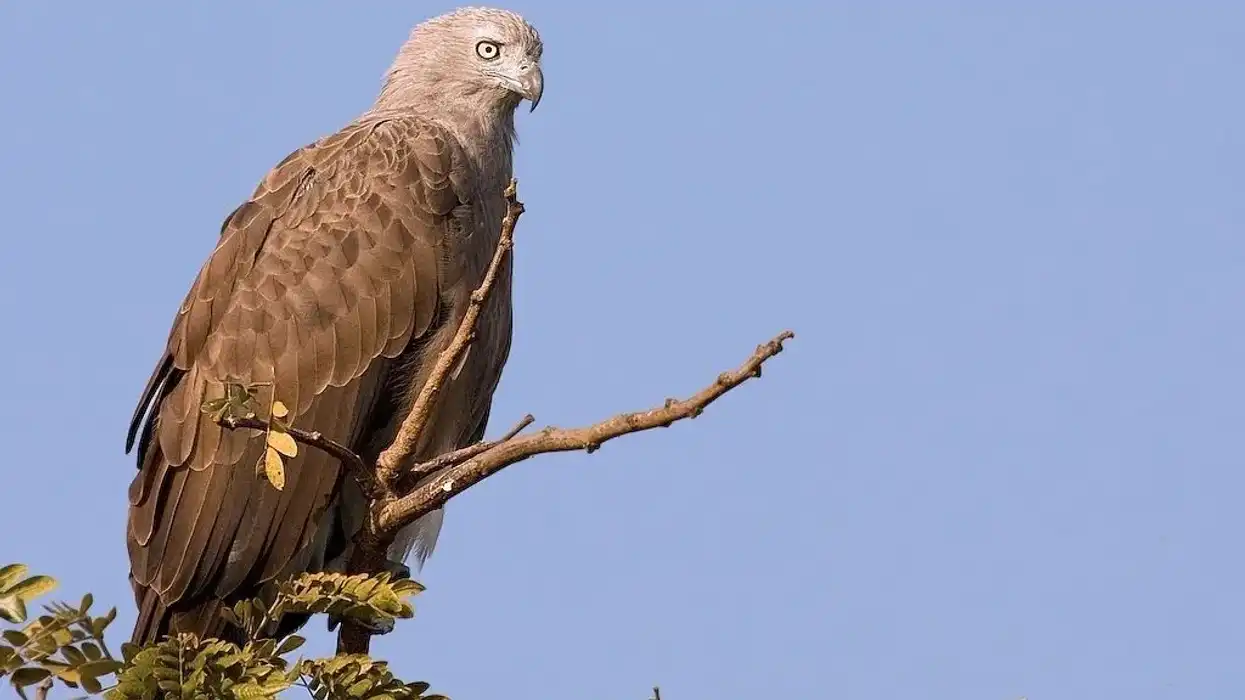The lesser black-backed gull (Larus fuscus) is a medium to large, long-winged, slender, and white-headed bird of the Laridae family of the kingdom of Animalia. This bird has a white head, dark gray back, yellow legs, black wingtips, and a yellow bill with a red spot near the tip of the lower mandible.
It takes four to five years for the young birds to reach adult plumage.
Juvenile plumage is dark dusky brown with whitish feathers, a black bill, dark band on the tip of tail, and neatly barred wings. The final adult plumage is streaked on the lower body with dark gray feathers, black wingtips, brown speckles on the inner wing, and a faint tail band.
This bird is similar to the herring gull, both in appearance and lifestyle, except for being smaller and more agile in flight.
It is found in Ireland, along the Atlantic coasts of Europe, the British Isles, Iberia, Florida, the Faeroe Islands, North America, Iceland, Greenland, and West Africa. The first-ever lesser black-backed gull was found in 1802.
It is an omnivore and its diet includes fish, insects, worms, starfish, marine worms, mollusks, rodents, young birds, crustaceans, seeds, eggs, berries, seaweed, and small mammals.
It also steals food from other birds. Its natural environment is predominated by beaches, bays, coast, garbage dumps, fishing harbors, estuaries, coastal islands, and the Green Lakes.
This bird's average lifespan is 15 years. It makes a sound like a strident 'kyow' when calling other birds from a different bird colony or even the same bird colony.
The lesser black-backed gull breeds colonially, on the coast and lakes and makes a nest on a cliff, roof of a building, or the ground. It is not a nesting bird in North America yet.
The average litter size is three. The clutch is brown, olive to blue-green.
The nests are built by both parents and they even feed the juvenile together. The incubation period is 24-27 days, and although the juvenile leaves the nest after a few days, it lives nearby.
It takes its first flight after 30-40 days and starts to breed when four years old. The five recognised subspecies of lesser black-bucked gulls are L. f. graellsii, L. f. intermedius, L. f. fuscus, L. f. heuglini, and L.f. barabensis.
According to The International Union for Conservation of Nature (IUCN) Red List of Threatened Species, their population trend is stable and their conservation status is of Least Concern.
However, they are threatened by habitat alteration and destruction, capture for the pet trade, avian botulism, and sport hunting.
This bird is extremely cute and very adorable to watch with its white and gray body and a cute inky head. This seabird is not particularly a threat to humans, but it is an opportunistic predator and scavenger of the wild and is very dangerous to the other animals in its coastal ecosystem.
The natural environment of these birds is near water bodies, and keeping it caged might make it feel isolated and aggressive.
For more relatable content, check out these laughing gull facts and glaucous gull facts for kids.
Lesser Black-Backed Gull Interesting Facts
What type of animal is a lesser black-backed gull?
The lesser black-backed gull (Larus fuscus) is a large seabird that belongs to the Laridae family.
What class of animal does a lesser black-backed gull belong to?
The lesser black-backed gull belongs to the Aves class and the kingdom of Animalia.
How many lesser black-backed gulls are there in the world?
Unfortunately, there are no records that tell us the exact population of lesser black-backed gulls (Larus fuscus) in the world. This bird species has an extremely large range and its population trend is stable.
Where does a lesser black-backed gull live?
This sea bird breeds along the Atlantic coasts of Europe and Iceland and migrates from the British Isles to West Africa, and visits the east coast of North America and Florida in the winter season. Its recent arrival is in Greenland.
What is a lesser black-backed gull's habitat?
The gull lesser black-backed species inhabits waters near the seacoast and lakes. Their natural environment is predominated by beaches, bays, coast, garbage dumps, fishing harbors, estuaries, coastal islands, and the Green Lakes in Canada.
Who does lesser black-backed gull live with?
Not much is known about its nature and lifestyle, but this bird likes to nest with the herring gull in urban cities.
How long does a lesser black-backed gull live?
The average lifespan of a black-backed gull lesser is 15 years. However, the longest record of a living black-backed gull lesser is 34 years, 10 months, and 27 days.
How do they reproduce?
The gull lesser black-backed breeds colonially on the coast and lakes, and makes a nest on a cliff, roof of a building, or the ground. It is not a nesting bird in North America yet.
The average litter size of these sea birds is three. The clutch is brown, olive to blue-green. The nest is built by both parents, and they even feed the juvenile together.
The incubation period is 24-27 days, and although the juvenile leaves the nest in a few days, it lives nearby. It takes its first flight after 30-40 days and starts to breed when it is four years old.
What is their conservation status?
Since their population is stable, the conservation status of gull lesser black-backed according to The International Union for Conservation of Nature (IUCN) Red List of Threatened Species is Least Concern. The main threat to these birds is habitat alteration and destruction, capture for the pet trade, avian botulism, and sport hunting.
Lesser Black-Backed Gull Fun Facts
What does a lesser black-backed gull look like?
Lesser black-backed gulls are 20–25 in (51–64 cm) long and weigh around 0.996-2.425 lb (45-1,100 g). These medium-sized gulls have a white head, dark gray back, a yellow bill with a red spot near the tip of the lower mandible, a faint tail-band, yellow legs, and black wingtips. They look very similar to herring gulls.
How cute are they?
They are extremely cute and very adorable to watch. These sea birds have a white and dark gray body and a cute inky head. Their brown, olive to blue-green clutch is also very cute.
How do they communicate?
Its call is a laughing cry that is very similar to that of the herring gull. The only difference is that the lesser black bucked-gull has a deeper and more nasal pitch.
How big is a lesser black-backed gull?
The backed gull lesser black is 20–25 in (51–64 cm) long. It is almost the same size as the ring-billed gull.
How fast can a lesser black-backed gull fly?
A backed gull lesser black may fly as fast as 27.34-60.90 mph (44-98 kph).
How much does a lesser black-backed gull weigh?
The weight of the backed gull lesser black ranges from 0.996–2.425 lb (452–1,100 g).
What are the male and female names of the species?
Adults are known by the same scientific name, Larus fuscus, but do not have any sex-specific name for the male and female species.
What would you call a baby lesser black-backed gull?
The baby name of this bird species is juvenile birds or chicks.
What do they eat?
The black-backed gull lesser is an omnivore and its diet includes fish, insects, worms, starfish, marine worms, mollusks, rodents, young birds, crustaceans, seeds, eggs, berries, seaweed, and small mammals. The adults also steal food from other birds.
Are they dangerous?
This bird species is not particularly a threat to humans, but they are opportunistic predators and scavengers of the wild and are very dangerous to other animals in their coastal ecosystem.
Would they make a good pet?
There is no information about whether these gulls can be adopted as a pet. The natural environment of this bird species is near water bodies, and keeping them caged might make them feel isolated and aggressive. They will not make a good pet.
Did you know...
The first-ever black-backed gull lesser was found in 1802.
How do you identify a lesser black-backed gull?
It takes four to five years for the backed gull lesser black to reach adult plumage. The juvenile plumage is dark dusky brown with whitish feathers, black bill, dark band on the tip of tail, and neatly barred wings.
The final adult plumage is streaked on the lower body, dark gray feathers, black wingtips, brown speckles on the inner wing, and a faint tail band.
What is the difference between greater and lesser black-backed gulls?
This seabird species, Larus fuscus, is smaller than the largest member of the gull family, Larus marinus. It has a paler gray back and yellow legs, whereas greater black-backed gulls have a darker gray back, and pink legs.
Here at Kidadl, we have carefully created lots of interesting family-friendly animal facts for everyone to discover! Learn more about some other birds from our bowerbird facts and hummingbird facts pages.
You can even occupy yourself at home by coloring in one of our free printable Lesser black backed gull coloring pages.









